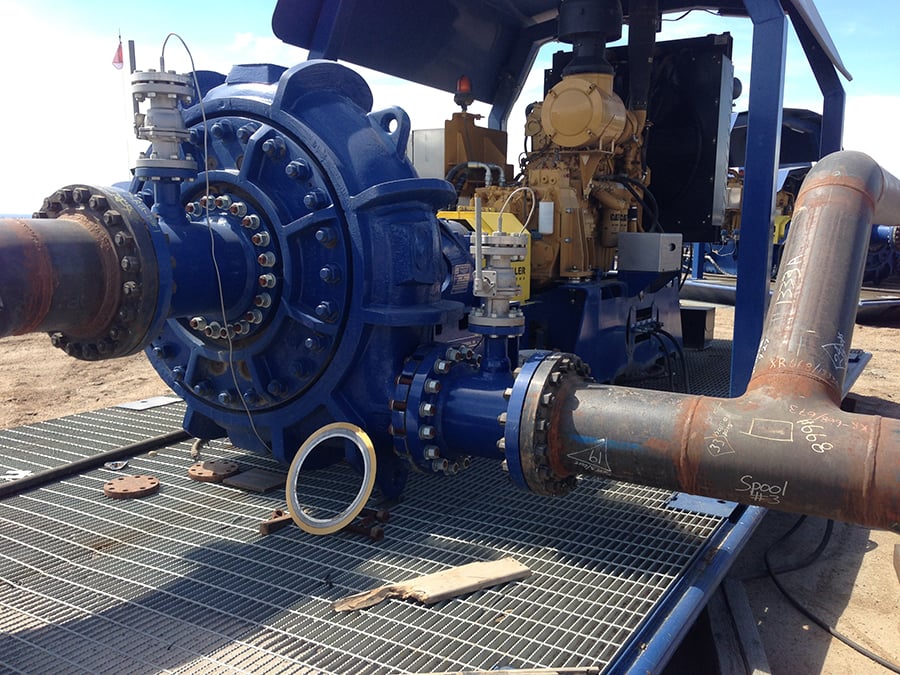
If you work in the Oil Sands, you’re no stranger to tough, remote conditions — and neither is your equipment. However, our harsh winters can be especially hard on slurry systems, particularly if you haven’t properly winterized your pumps.
With so much moisture present during operation, slurry pumps become notably vulnerable to damage in cold weather. Frozen water in your pump system can lead to crippling issues ranging from improper functioning and premature parts failure all the way to more costly damage caused by freeze-and-thaw issues or thermal shock.
The good news is — with a little preparation and careful operation — your system can be winterized without trouble. Here are five steps to help you maintain your system in extreme cold conditions:
- Protect your pipes and pumps from the elements.
Since mechanical seals and bearings are particularly vulnerable to damage while operating in freezing conditions, protect them by heat tracing and wrapping your seal water piping. A heated shelter is ideal, but not every slurry pump in the Oil Sands has this luxury. If this is not practical, do not stop the slurry flow! Instead, find a way to protect your pump from the elements and use an appropriate heat source to raise the temperature of the bearing assembly, lubricating oil, and pump casing before starting it up. Look to your local codes to determine the most suitable heat source for the job. - Prevent freezing during shutdowns.
If you’re shutting your unit down in sub-zero conditions, make sure it’s completely free of water so it doesn’t freeze, expand, and result in damage. Some pumps are designed for periodical stops with built-in plugs in the shell base. However, other systems require you to remove the system piping and pump out the casing. Looking for another option? Install a dump valve in the lowest point of the piping system and use it. Whichever method you choose, don’t forget about the stuffing box and lines.
When temperatures drop below freezing, water trapped in the impeller hub cavity can freeze and cause cracking or complete fracturing of the impeller hub. One way to prevent damage to the impeller hub is to install a GIW Neoprene disc in the bottom of the impeller hub. The Neoprene disc acts as a cushion to protect the impeller if left installed in sub-freezing conditions. Contact your GIW® slurry pump representative for part numbers and installation instructions.
- Check your oil.
Your pump’s bearings will need extra attention during the winter months. That’s because any moisture or condensation inside the bearing races will quickly turn to ice, preventing smooth movement in the assembly and resulting in damage and untimely failure. Before cold weather arrives, change your CBA oil and check the viscosity or "weight" of the oil against the coldest expected air temperature to ensure the oil is correct for the conditions. Depending on your bearing size, a synthetic oil may be recommended. Unlike traditional mineral oils, the pour point of synthetics is designed to maintain effective lubrication at low temperatures. - Prepare your pneumatics and v-drives.
If your isolation valves are pneumatically actuated, make sure your air dryer is functioning optimally. For v-drives, consider installing new belts for the winter so you don't have to deal with replacing them when it's negative 40 degrees. - Operate with care.
When operating your slurry system in a wintery environment, take care to properly start up and oversee your system. Your pump casing should always be brought up to operating temperature gradually, either with process flow or external heat, to prevent thermal shock. The stuffing box also needs a constant supply of water, which may need to be insulated or heated, and flush water must be drained to prevent ice buildup.
These tips should help you keep your slurry system in working order through the winter and beyond. For those seeking to upgrade their system or purchase new pumps for their line, it’s also important to keep in mind that pumps and slurry systems can be designed with harsh environments — and severe temperature fluctuations — in mind.
By working with an expert who is familiar with your environment and your needs, you can rely on a slurry system that’s prepared for anything — even a frigid winter in the Canadian Oil Sands!
